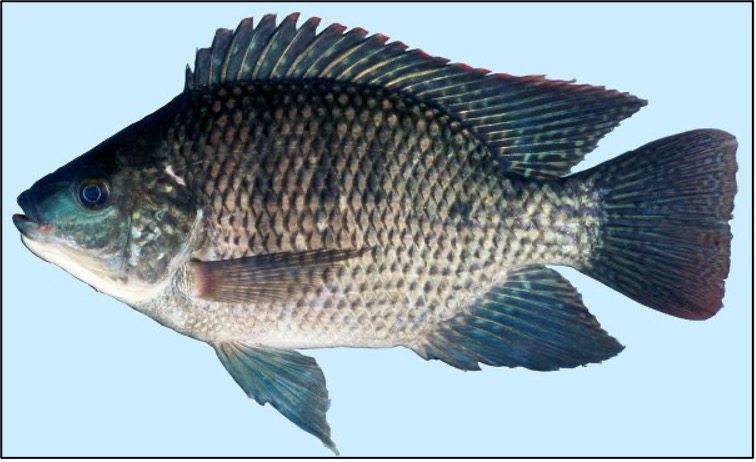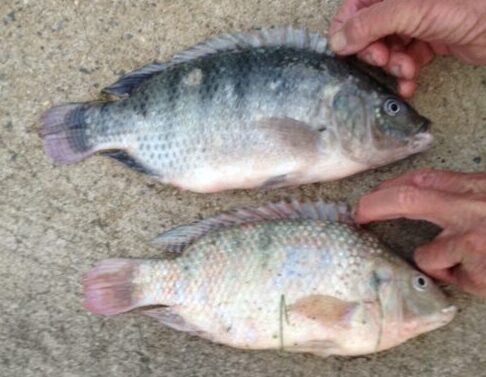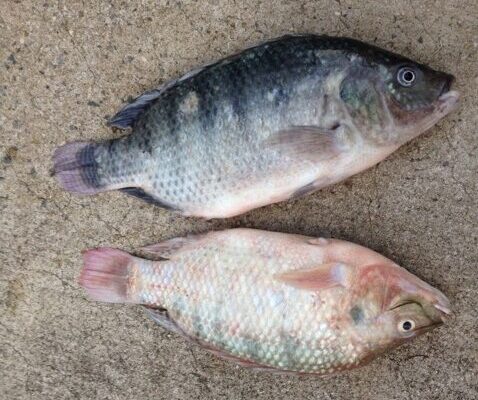By the NCFishes.com Team
The Family Cichlidae, known collectively as cichlids, is a very diverse (about 1600 species) family of fishes indigenous to tropical and subtropical fresh and brackish waters of Mexico, Central and South America, the West Indies, Africa, the Middle East, and the Indian subcontinent. Only one species, the Ro Grande Cichlid, Herichthys cyanoguttatus, is native to the United States where it is found in Texas (Fuller et al. 1999). In the United States they are popular in the aquarium trade and in aquaculture ultimately for human consumption. Unwanted and/or overgrown aquarium fishes are often dumped illegally into local ponds, lakes, and waterways. More than 60 nonindigenous species have been found in waters of the United States (https://nas.er.usgs.gov/queries/SpeciesList.aspx?specimennumber=&group=Fishes&state=&family=Cichlidae&genus=&species=&comname=&status=0&YearFrom=&YearTo=&fmb=0&pathway=0&nativeexotic=0%20&Sortby=1&size=50, accessed 03/03/2021).
There are two nonindigenous species of cichlids in North Carolina with established, reproducing, and until recently, persistent populations: Redbelly Tilapia, Coptodon zilli, and Blue Tilapia, Oreochromis aureus. (NCFishes.com; Tracy et al. 2020). [Please note: Tracy et al. (2020) may be downloaded for free at: https://trace.tennessee.edu/sfcproceedings/vol1/iss60/1.] The two common names, Redbelly Tilapia and Blue Tilapia, are the American Fisheries Society-accepted common names (Page et al. 2013) and each of the scientific (Latin) names actually means something (please refer to The Meanings of the Scientific Names of Cichlids, page 5). Redbelly Tilapia can reach a length of 320 mm (12.5 inches) and Blue Tilapia a length of 370 mm (14.5 inches) (Page and Burr 2011).
Redbelly Tilapia was originally stocked in Sutton Lake (Cape Fear basin), in Duke Energy’s Weatherspoon cooling pond near Lumberton (Lumber basin), and in PCS Phosphate Company’s ponds near Aurora (record not mapped; Tar basin) in attempts to manage aquatic macrophytes. It was also inadvertently introduced into Hyco Reservoir (Roanoke basin) from an on-site aquacultural study (Map 1; Fuller et al. 1999; Tracy et al. 2020). [Note: see Supplemental Maps 1-3, page 6, showing North Carolina’s 100 counties, 21 river basins, and 4 physiographic regions.] Except for Hyco Reservoir, sustaining populations are no longer evident in the other three localities because of the species’ intolerance to ambient low water temperatures during the winter. Its future persistence in Hyco Reservoir is in doubt because the power generating plant is no longer discharging as much heated effluent as it used to.

Blue Tilapia was stocked in 1965 as a forage fish and to control aquatic macrophytes in the newly constructed Lake Julian (French Broad basin); introduced into Lake Norman for unknown reasons (Catawba basin), and, like Redbelly Tilapia, was similarly accidentally introduced into Hyco Reservoir from an on-site aquacultural study during 1984 (Fuller et al. 1999; Tracy et al. 2020) (Map 2). This species was not expected to survive in Lake Julian because the thermal discharge from the coal-fired and gas-fired power generating plant ceased in February 2020 (Reid Garrett, Duke Energy, pers. comm.). It is unknown if the record mapped for Lake Norman represents a persistent and reproducing population or if it was the remnant of a one-time bait bucket release.

One additional species, Nile Tilapia, Oreochromis niloticus, was anecdotally reported by Henson et al. (2018) as occurring in North Carolina. Captured in September 2014 with a cast net near Duke Energy’s Allen Steam Station near Belmont, on Lake Wylie, Gaston County (Catawba basin), at least two specimens of what were thought to be Nile Tilapia were preserved frozen and were to be given to a state resource agency or museum (Corey Oakley and Chris Woods, North Carolina Wildlife Resources Commission, pers. comm.). Nile Tilapia may be differentiated from Blue Tilapia by the number of dorsal spines and rays, banding on the caudal fin, breeding coloration of males, and color of the dorsal fin margin (https://nas.er.usgs.gov/queries/FactSheet.aspx?SpeciesID=468, accessed 03/03/2021).
Although there are photographs of the two specimens (Figure 1) that showing banding on the caudal fin of the more darkly pigmented specimen indicative of a Nile Tilapia, the whereabouts of the actual specimens are unknown and a definitive identification of the fishes is impossible. Since 2014, there have been no records of Nile Tilapia survival or collection from waters in the vicinity of the Allen Steam Station or further down reservoir near the Catawba Nuclear Plant in South Carolina (Ryan Heise and Nick Wahl, Duke Energy, pers. comm.).
Figure 1. Possibly Nile Tilapia collected from Lake Wylie, Gaston County, North Carolina, September 2014. Photographs supplied by Chris Woods, North Carolina Wildlife Resources Commission; photographer unknown.
Other species of cichlids, for example, Oscar, Astronotus ocellatus, and Mozambique Tilapia, Oreochromis mossambicus, have also been reported from North Carolina (https://nas.er.usgs.gov/queries/SpeciesList.aspx?group=Fishes&state=NC&Sortby=1, accessed 03/03/2021), but surviving and reproducing populations have not known to have occurred (Tracy et al. 2020).
The identification of our two species of cichlids is relatively straight-forward. Key characteristics for their proper identification include color patterns and the number of gill rakers on the first gill arch (please refer to the Identification Key to the Cichlids (Family Cichlidae) in North Carolina).
If you have troubles with your identifications, just send us (https://ncfishes.com/contact/) an e-mail and include as many quality digital photographs as you can along with all the pertinent locality descriptors so that we will know from where the fish came.

